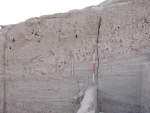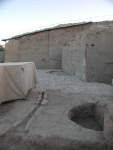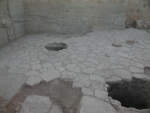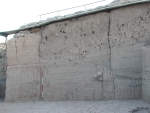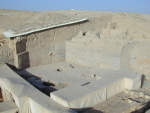1. OVERVIEW
| Roster | Date | Author | Record |
|---|---|---|---|
| Category | !! | !! | installation |
| Best definition | 2001-08-18 | !! | pit [Input: L724LR.j] |
| Best image | 2011-12-12 | lC | 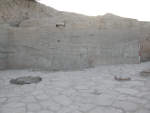 v139 [Input: VZ12LC.j] |
2. IDENTIFICATION
Designation
| Roster | Date | Author | Record |
|---|---|---|---|
| Definition | 2001-08-18 | lR | pit [Input: L724LR.j] |
| Description (summary) | 2001-08-18 | lR | large Khabur pit [Input: L724LR.j] |
3. STRATIGRAPHY
Recovery/Assignment
| Roster | Date | Author | Record |
|---|---|---|---|
| Daily notes about recovery of elements | 2001-07-28 | lR | We are finally approaching the end of this great Khabur pit with red material f157 and f181 wall appearing in the West with gray pit fill still to the East. In k6 North section the accumulation from a2 is seen very nicely which forms a bowl. The gray from a13 pit underneath forms bands of lighter gray sloping West to East with the Western portion higher. Alternating layers of gray are seen, light gray, dark, light, dark forming a bowl shape towards the East. If this is a pit, then it is quite large for it must extend the same length to the East making the pit almost 10 meters in diameter. [Input: L728LR.j] |
| 2001-07-29 | lR | We met with gb today to discuss the phases, and he suggested that the fill we are excavating in k6,k5,and k2 is not a pit but large hollows created by depressions in the palace that conditioned the topography, which then was used as dumps. So they were not cut, but natural in a sense that they occurred naturally after the palace collapsed. These hollows provided a ground for dumping which was filled up with 5a material but in the lower end of the hallow we find strata 4 material underneath. This level may be the stratum to which the tannur f180 and the accumulation around it belong. fab mentioned that the tannur may be related to the tannur found in A12, which was on top of the palace wall. [Input: L728LR.j] | |
| 2001-08-02 | lr | While excavating inside k108 we noticed a clear line forming a circular pattern, which we defined as the cut of the pit/hollow a13. This cut links all the material in former k2 and k6 (below a11 and a2) together since it all belongs to the same pit a13. A hard compact reddish-brown material that forms a massive accumulation measuring approximately 50cm in thickness marks this cut. The material inside the circle (the fill) peels away easily from the red material and also curves slightly in at the base. The fill inside the circle is gray-brown, softer and full of pottery and bones. While removing the fill of a13 we did encounter a layer of chunky hard clay. [Input: L815LR.j] | |
| 2001-09-02 | lR | We are excavating a vertical section of this pit left in place since a2 conditioned a hump to form. This vertical section has been termed the "pillar" and we are excavating it in layers. [Input: L903LR.j] | |
| Procedures | 2001-09-02 | lR | we excavated the east baulk pillar by layers. The first feature is the interface between the accumulation from the phase 5b houses from a2 and a11 and the beginning of the pit a13. The first 30 cm contains a reddish compact layer with the brick foundations seen in the section. This layer serves as a seal between phase 5b and earlier Khabur material. The next layer contains soft ashy fill 83 cm in thickness. This material is darker than the rest of the material in the pillar and contains chunks of reddish pink clay, and flakes of charcoal a clear line between this feature and the one below is marked by a thin band of pottery. The next layer was removed which was called an interface layer between the ashy accumulation and the more compact light gray underneath. The remaining material was separated not by layers since it appears that the matrix is the same, but by 30cm increments to keep the pottery separate. We are using the pillar as a good documentation of the stratigraphy of the pit and keeping careful separation between each layer by ensuring that the area is cleaned and all pottery collected before proceeding to the next layer. The pillar was excavated by one person at a time using a ladder and a big pick. The person excavating the pillar was directed by someone below as to when the layer changed. The pillar was then scrapped and all the pottery collected with the khabur sherds separated. [Input: L903LR.j] |
Volumetric Localization
| Roster | Date | Author | Record |
|---|---|---|---|
| Locus | 2001-06-17 | fAB | k2 k5 k6 k110 [Input: L724LR.j] |
| 2001-08-18 | lR | k108 [Input: L724LR.j] |
Spatial Aggregation
Time Sequencing
| Roster | Date | Author | Record |
|---|---|---|---|
| Stratum (to which element belongs) | 2000-12-18 | !! | s255AAH [Input: A-CUMUL.j] |
| 2015-05-20 | !! | s244AAH s265AAH s270AAH s310AAH s315AAH [Input: ZA520CJC.j] |
|
| Phase (to which element belongs) | 2000-12-18 | !! | h6hAAH [Input: A-CUMUL.j] |
| 2015-05-20 | !! | h5hAAH [Input: ZA520CJC.j] | |
| 2015-05-20 | !! | h6cAAH [Input: ZA520CJC.j] | |
| 2015-05-20 | !! | h6hAAH [Input: ZA520CJC.j] | |
| 2015-05-20 | !! | h6mAAH [Input: ZA520CJC.j] |
6. REFERENCE
Analogical Record
| Roster | Date | Author | Record |
|---|---|---|---|
| Photo of context (v view) | |||
| View/drawing of aggregate | |||
